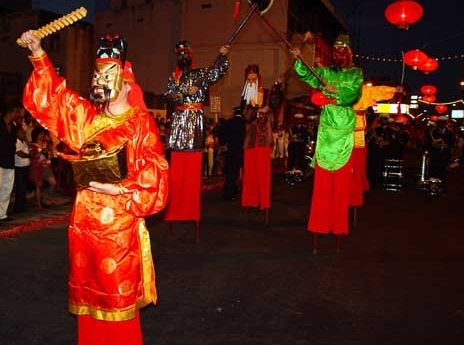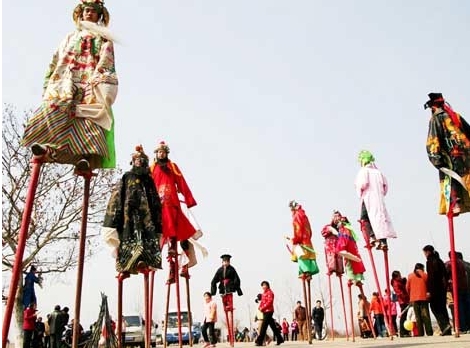
Stilt, or "Crutch", is a form of folk performing art in China. It is performed by a dancer walking on wooden stilts and is a folk art which perfectly combines laboring with dance and music. It is also known as "Upward Viewing Drama" because the audience need to raise their head to view the performance.

The origin of stilt has bearing on totem worship of the primitive clans and the life of fishermen living along coasts. Danzhu clan in the Yaoshun Period took crane as their totem and would dance imitating crane by walking on stilts during the worship ceremony. Records regarding "Changgu Kingdom" in The Classic of Mountains and Rivers present the scene of fishing on the sea by fishers walking on long wooden stilts and holding lengthy fishing tools in their hands. This custom is still prevalent among the fishers of Jing ethnics living along sea coast in Fangcheng City, Guangxi Zhuang Autonomous Region.
It was described in books introducing stilts of the Jin Dynasty in China that a person tied with crabsticks which are two times longer than his body on the lower legs is flinging and taking back seven daggers when running, which indicates that stilt performance was a kind of skillful acrobatics in the Wei and Jin Periods. In the Sui and Tang Dynasties, stilt performance was an entertainment named "Long Stilt Trick". It was developed into a folk dance in the Southern Song Dynasty, with the occurrence of a range of stilt performing programs such as "Flapping Butterfly". In the Ming and Qing Periods, stilt performing was combined with Yangko (popular rural folk dance in China) with a name of "Stilt Yangko".
Stilt performance is usually seen in Shanxi, Shandong, Beijing, and northeast China, and so on. Every region possesses different stilt performing forms. Stilt performance can be classified into two types: gentle stilt performance and valiant stilt performance. The former focusing on the performer's appearance and amusing motions, and the latter emphasizes on personal techniques and unique skills such as "hopping", "splitting", "obstacle surmounting" and other stunts. For instance, in the stilt performance named "Cloud Mounting Meeting" held in Zhangxie Village in Fangshan District of Beijing, the performer is able to walk on a single 140cm-long stilt and jump from the top of four piled tables, which is really a stunning skill. Stilt performance was listed as the national intangible culture heritage in 2006.





